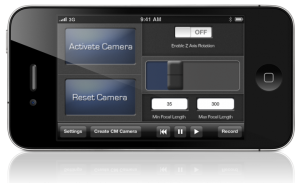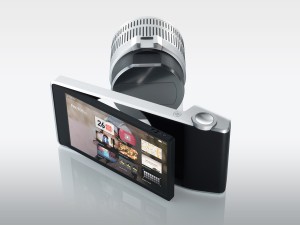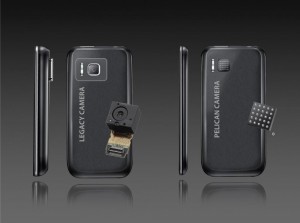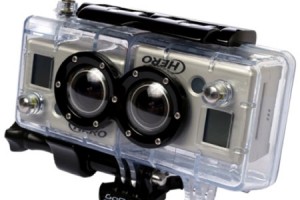Wes McDermott (“the 3D Ninja”) has released version 1.0.2 of his app for creating handheld camera animations in Autodesk Maya 3D software. CameraMan for Maya is an interesting new utility app for the iPhone 4, iPod touch and iPad 2 (currently available for $1.99 on iTunes).
 The app uses the Apple devices’ gyroscope hardware as a motion capture device to control X, Y and Z rotations of the camera. It enables users to adjust the focal length with a slider, record animation, and provides Maya timeline playback controls. The 3D Ninja Blog features a helpful 29-minute video tutorial.
The app uses the Apple devices’ gyroscope hardware as a motion capture device to control X, Y and Z rotations of the camera. It enables users to adjust the focal length with a slider, record animation, and provides Maya timeline playback controls. The 3D Ninja Blog features a helpful 29-minute video tutorial.
Requirements (according to the CameraMan for Maya iTunes page): Compatible with iPhone 4, iPod touch (4th generation), iPad 2 Wi-Fi, and iPad 2 Wi-Fi + 3G. Requires iOS 4.1 or later.

By
Rob ScottApril 25, 2011
Artefact asks “What’s next in digital camera design?” with an interesting new prototype called the WVIL (Wireless Viewfinder Interchangeable Lens). According to the Artefact site: “The patent-pending WVIL system takes the connectivity and application platform capabilities of today’s smart phones and wirelessly connects them with interchangeable full SLR-quality optics. It is the inevitable solution for photographers who expect the power of modern mobile devices but who also demand uncompromised quality.”
 In an article that features two compelling videos, Fast Company’s Co. Design suggests the WVIL provides a possible glimpse at the future of photography if digital cameras and cellphone cameras continue to merge, “leaving just a lens with a chip and a screen on the back of it.”
In an article that features two compelling videos, Fast Company’s Co. Design suggests the WVIL provides a possible glimpse at the future of photography if digital cameras and cellphone cameras continue to merge, “leaving just a lens with a chip and a screen on the back of it.”
Artefact explains that many possibilities stem from this idea. According to Markus Wierzoch, WVIL’s lead industrial designer: “With the first digital cameras, the industry was quick to replace the medium, film, with a sensor, but the rest stayed the same. But modern connectivity opens up a lot of different options, like being able to detach the lens from the viewfinder. What if you could go to a party, mount three or four lenses all over the room, and control them all wirelessly with one ‘camera’?”
The Artefact team has cleverly redesigned the digital camera as “a camera operating system,” one that can be controlled from a touchscreen-based viewfinder and could quite possibly appeal to prosumer photographers who have outgrown their traditional DSLRs and no longer want a bag full of expensive gear. Artefact believes the WVIL could become a reality within three years.

By
Rob ScottApril 19, 2011
According to Flickr’s “camera finder” feature, the iPhone 4 is heading towards becoming the most popular “camera” used to submit images to the photo-sharing site. Is the iPhone (and other smartphones with improved camera features) disrupting the point-and-shoot market?
Flickr’s camera finder provides a graph detailing the most popular cameras in the Flickr community, with the Nikon D90 currently at the top. However, the iPhone 4 is on the rise, while traditional point-and-shoot cameras are steadily declining. If the trend continues, the iPhone is poised to take the lead in the near future.
This isn’t the first time a phone may prove more popular than a traditional camera on Flickr. PC World reports that in August 2009, the iPhone edged by the Canon Digital Rebel XTi as the most popular (back when the best iPhone camera only featured 3.2-megapixel resolution).
We recently reported that Cisco had shut down production on the popular Flip camera line, possibly in response to smartphones’ ability to shoot HD video. Is the iPhone still proving disruptive, four years after its initial release? According to GigaOM: “The takeaway is that smartphones are nearing the tipping point in terms of camera quality when it comes to the needs of most average users (professional and prosumer DSLRs continue to do well), and the iPhone 4 is leading that charge. Phones provide a much more convenient on-hand camera experience than do dedicated devices, and the trade-offs in terms of quality and feature are becoming less significant all the time.”
Related PC World story: “iPhone 4 About to Be Most Popular Camera on Flickr” (4/18/11)

By
Rob ScottApril 12, 2011
Pelican Imaging announced its prototype “array camera” for mobile devices that uses multiple lenses to record a single high-quality image. The company hopes this will appeal to manufacturers who want to make a slimmer smartphone, and to users interested in leveraging computational imaging (adding features such as the ability to alter focus after an image has been captured).
 The three-year old company has received $17 million in venture funding. Its technical advisory board includes Marc Levoy, who co-designed the Google book scanner and helped launch Google Street View; Shree Nayar of Columbia’s Computer Vision Laboratory; and Bedabrata Pain, who co-invented active pixel sensor technology for mobile phone cameras.
The three-year old company has received $17 million in venture funding. Its technical advisory board includes Marc Levoy, who co-designed the Google book scanner and helped launch Google Street View; Shree Nayar of Columbia’s Computer Vision Laboratory; and Bedabrata Pain, who co-invented active pixel sensor technology for mobile phone cameras.
“Pelican’s technology has the potential to upset the traditional tradeoff between the sensitivity and resolution of a camera and its thickness,” Levoy said, adding “Pelican’s solution is small, fast and inexpensive — which makes it a very exciting technology.” According to Nayar, the technology is a “paradigm shift in imaging and video” likely to “bring computational imaging applications to the mass market.”
Check out this Engadget post to see a video about observing a scene with multiple cameras through synthetic aperture photography.
Related CNET article: “Pelican shows slim phone-camera prototype” (2/9/11)
For more information, visit the Pelican press release.

By
Rob ScottApril 11, 2011
GoPro is gaining in consumer popularity thanks to its collection of Hero Camera mounts that allow users to attach inexpensive cameras to everything from ski helmets to the tips of surfboards for action footage. Already popular with skiers, snowboarders, surfers, bikers and other outdoor enthusiasts and extreme athletes, the GoPro line is starting to become more common with professional cameramen as well. Nature photographers, in particular, are using GoPro products to shoot footage of hard-to-reach places, such as inside a cobra’s den or a shark’s mouth.
 The small, six-ounce, 1080p camera comes with a water-tight housing and starts at $260.
The small, six-ounce, 1080p camera comes with a water-tight housing and starts at $260.
GoPro’s parent company, Woodman Labs Inc., is receiving funding from outside investors, including Steamboat Ventures, a venture capital fund backed by Disney (Steamboat Ventures was also an investor in Pure Digital, maker of the popular Flip pocket camcorder). Steamboat plans to help GoPro expand further into the professional market.
Gizmodo offers a positive review of the 3D Hero System — a $99 3D kit (cameras not included) that GoPro bills as “the world’s smallest 1080p 3D camera.” The system combines two HD cameras in a waterproof housing that enables users to shoot synchronized photos and video (2D and 3D) that can then be edited in 3D with the free CineForm Studio software.
Most helmet and similar cameras have gone to wide angle lenses to ensure footage and minimize shake. The result was effective, but made things look smaller when viewed. Gizmodo notes that “adding 3D gives depth to the trees and objects rushing past you,” providing for a more immersive viewing experience.
You can check out the GoPro video demo to see how the 3D Hero System works.
Related Wall Street Journal story: “Camcorder Popular With Surfers Looks to Ride Professional Market” (4/6/11)
By
Rob ScottMarch 9, 2011
Billed as “the world’s first camera-top wireless HD video encoder,” the Cube from Irvine, CA-based Teradek streams up to 1080p over Wi-Fi, Verizon 4G, and wired Ethernet.
The battery-powered H264 encoder sends video directly from a camera to a decoding device such as a laptop or iPad. The Cube is available in HD-SDI and HDMI models running in the $1500-2000 range, and is designed for those in the business of live streaming — or those looking for production solutions such as on-set video monitoring or eliminating the need for camera tethering.
To operate, the Cube slides into the camera’s hot shoe and goes live with a single button via Livestream.com. Gizmodo reports the process is “unhampered by firewalls, blocked ports, and other network roadblocks.”
Early adopters earn a month of Livestream.com premium membership (about a $350 value) with a Cube purchase.








